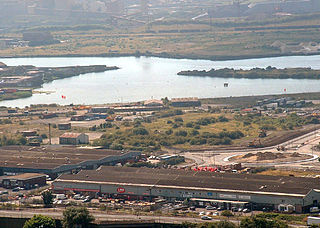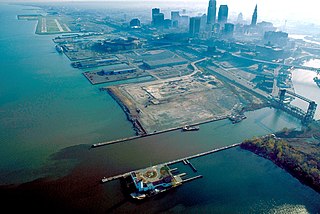
A barge is a shoal-draft flat-bottomed boat, built mainly for river and canal transport of bulk goods. Originally barges were towed by draft horses on an adjacent towpath. Today, barges may be self-propelled, usually with a slow-revving diesel engine and a large-diameter fixed-pitch propeller. Otherwise, "dumb barges" must be towed by tugs, or pushed by pusher boats. Compared to a towed barge, a pusher system has improved handling and is more efficient, as the pushing tug becomes "part of the unit" and it contributes to the momentum of the whole.
The Port of London is that part of the River Thames in England lying between Teddington Lock and the defined boundary with the North Sea and including any associated docks. Once the largest port in the world, it is the United Kingdom's second largest port, after Grimsby & Immingham as of 2012. Usage is largely governed by the Port of London Authority ("PLA"), a public trust established in 1908; while mainly responsible for coordination and enforcement of activities it also has some minor operations of its own.

The Port of Miami, styled as "PortMiami" but formally the Dante B. Fascell Port of Miami, is a major seaport located in Biscayne Bay at the mouth of the Miami River in Miami, Florida. It is the largest passenger port in the world, and one of the largest cargo ports in the United States. It is connected to Downtown Miami by Port Boulevard—a causeway over the Intracoastal Waterway—and to the neighboring Watson Island via the PortMiami Tunnel. The port is located on Dodge Island, which is the combination of three historic islands that have since been combined into one. It is named in honor of 19 term Florida Congressman Dante Fascell.

The Port of Melbourne is the largest port for containerised and general cargo in Australia. It is located in Melbourne, Victoria, and covers an area at the mouth of the Yarra River, downstream of Bolte Bridge, which is at the head of Port Phillip, as well as several piers on the bay itself. Since 1 July 2003, the Port of Melbourne has been managed by the Port of Melbourne Corporation, a statutory corporation created by the State of Victoria.

The Port of Alaska (POA) is a deep-water port located in Anchorage, Alaska with 3 bulk carrier berths, two petroleum berths, and one barge berth. It is an enterprise department of the Municipality of Anchorage. The name was changed from "Port of Anchorage" to the "Port of Alaska" in 2017. As such, the Port is distinguished from other types of municipal departments largely because it generates enough revenue to support its operations without being a burden to Anchorage property tax payers, and it also pays a fee-in-lieu of taxes to help run city government.

Belfast Harbour is a major maritime hub in Northern Ireland, handling 67% of Northern Ireland's seaborne trade and about 25% of the maritime trade of the entire island of Ireland. It is a vital gateway for raw materials, exports and consumer goods, and is also Northern Ireland's leading logistics and distribution hub.
The Port of Muskogee is a regional port, located on the McClellan-Kerr Arkansas River Navigation System in Muskogee County, Oklahoma, in the United States. It is a multi-modal local hub for the transport of goods via trucks, railroad, and barges on the Arkansas River. It is one of the farthest inland, ice-free year-round, United States ports that can access the Gulf of Mexico. It is located near the confluence of the Arkansas River, Grand River and Verdigris River in Oklahoma, at River Mile 393.8 of the McClellan-Kerr Arkansas River Navigation System,

The Port of Beaumont is a deep-water port located in Beaumont, Texas near the mouth of the Neches River.

The Port of Stockton is a major deepwater port on the Stockton Ship Channel of the Pacific Ocean and an inland port located more than seventy nautical miles from the ocean, in Stockton, California on the Stockton Channel and San Joaquin River-Stockton Deepwater Shipping Channel. The port sits on about 4,200 acres (17 km2), and occupies an island in the Sacramento–San Joaquin River Delta, and a portion of a neighborhood known as Boggs Tract. It is governed by a commission appointed by the City of Stockton and San Joaquin County. In 2012 it employed 4,500 people and made about $4.9 million in local tax funds.

The Port of Ashdod is one of Israel's two main cargo ports. The port is located in Ashdod, about 40 kilometers south of Tel Aviv, adjoining the mouth of the Lachish River. Its establishment significantly enhanced the country's port capacity. It handles the largest volume of cargo containers annually of all Israeli ports. Ships carrying humanitarian aid for the Gaza Strip also unload their cargo at Ashdod.
The Port of Montreal is a cruise and transshipment point located on the St. Lawrence River in Montreal, Québec, Canada. The port operates as an international container port where it services Toronto and the rest of Central Canada, the U.S. Midwest, and the U.S. Northeast. Though found on the Saint Lawrence Seaway and found 1,600 kilometres inland from the Atlantic Ocean, it is the shortest direct route between Europe and the Mediterranean, with the North American midwest.

Teesport is a large sea port located in the unitary authority of Redcar and Cleveland, in the ceremonial county of North Yorkshire, Northern England.

The port of Port Talbot is located on the River Afan estuary next to Port Talbot Steelworks in the industrial town of Port Talbot, South Wales. The whole basin complex covers about 500 acres (2.0 km2), consisting of: an inner set of floating docks, developed from 1834 onwards; and an outer tidal basin, completed in 1970. Owned and operated by Associated British Ports, the port of Port Talbot has the deepest berthing facilities in the Severn estuary and is one of only a few harbours in the UK capable of handling Capesize vessels of up to 170,000 tonnes deadweight (DWT), mostly for the import of iron ore and coal for use by nearby Port Talbot Steelworks.

The Port of Wilmington is a deep-water port located at the confluence of the Christina River and the Delaware River in Wilmington, Delaware, 65 miles (105 km) from the Atlantic Ocean. The port has been ranked as the top North American port for imports of fresh fruit, bananas, and juice concentrate, and as having the largest dock-side cold storage facility.
The Virginia Port Authority (VPA) is an autonomous agency of the Commonwealth of Virginia that owns The Port of Virginia, a group of facilities with their activity centered on the harbor of Hampton Roads, Virginia.

The Port of Cleveland is a bulk freight shipping port at the mouth of the Cuyahoga River on Lake Erie in Cleveland, Ohio, United States. It is the third-largest port in the Great Lakes and the fourth-largest Great Lakes port by annual tonnage.

The Port of Odessa or Odessa Sea Port — located near Odessa — is the largest Ukrainian seaport and one of the largest ports in the Black Sea basin, with a total annual traffic capacity of 40 million tonnes. The port has an immediate access to railways allowing quick transfer of cargo from sea routes to ground transportation. Along with its younger satellite ports of Chornomorsk (1958) and Yuzhne (1973), port of Odessa is a major freight and passenger transportation hub of Ukraine.

Blount Island is an island of approximately 2,000 acres (8.1 km2) on the St. Johns River in Jacksonville, Florida, nine nautical miles (16.7 km) west of the Atlantic Ocean. One of three public cargo facilities at the Port of Jacksonville is located there, and it is also the site of the United States Marine Corps Blount Island Command.
Port of Itaqui is a Brazilian port located in the city of São Luís, Maranhão. It is not to be confused with the city of Itaqui, in the state of Rio Grande do Sul, near the border with Argentina. The main cargoes include aluminum ingots and bars, pig iron, general, dry and liquid bulk cargoes, soybean and copper. The hinterland of the Port of Itaqui encompasses the states of Maranhão, Piauí, Tocantins, southwestern Pará, northern Goiás, northeastern Mato Grosso, and western Bahia.

ExpressRail is a rail facility network of on- or near- dock rail yards supporting intermodal freight transport at the major container terminals of the Port of New York and New Jersey. The development of dockside trackage and railyards for transloading has been overseen by the Port Authority of New York and New Jersey, which works in partnership with other public and private stakeholders. As of 2019, four ExpressRail facilities were in operation, with a total built capacity of 1.5 million lifts.

















